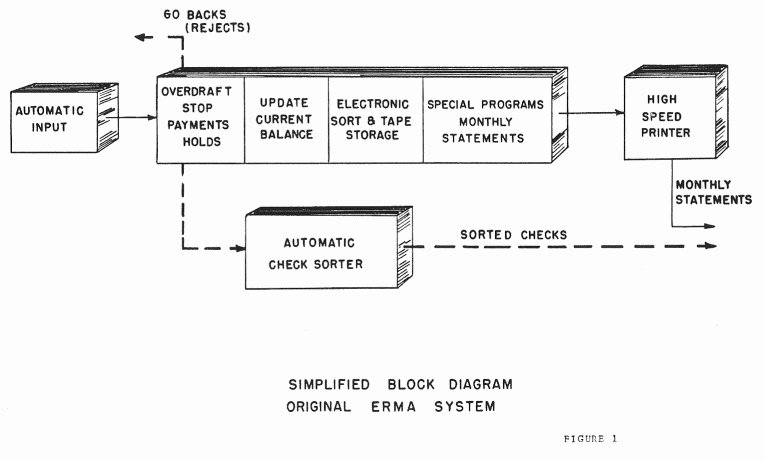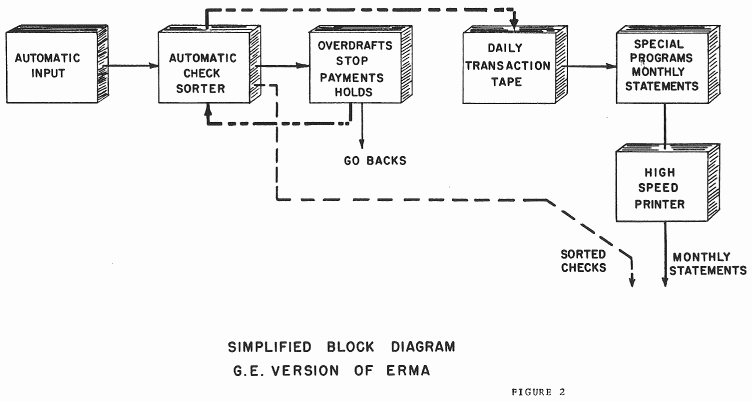|
ERMA - Its Meaning to General Electric by G. C. TROTTER Manager - Sales Industrial Computer Section The present rapid growth of the Industrial Computer Section is being made possible at least in part by the recent acquisition of a $30,000,000 contract from the Bank of America. This contract calls for the production of a quantity of 36 ERMA systems to mechanize the bookkeeping for their chain of 2,000,000 checking accounts. This is one of the largest single industrial computers orders ever placed, and it will have a Consider able effect on the future of General Electric in the computer field. As such, ERMA or Electronic Recording Machine Accounting deserves mention at this meeting. Five years ago when Stanford Research Institute, under sponsorship of the Bank of America, undertook the program of adapting high speed computer techniques to the problem of automatic check handling, there was little to guide them in the existing state of the art. At the start of their program, several large general purpose computers were in existence, but these were not acceptable as points of departure. An extremely large amount of data was to be handled by this equipment on a current basis with completely random order of input being assumed. From the above consideration, the original ERMA system was developed (Figure 1). Five input keyboard units, now superseded by one automatic input station, are used to feed data. The machine tests to see if there are reasons for not honoring the individual check and either rejects it or computes a Dew current balance for the account. Two large magnetic drums are used to store the current balances of all 50,000 accounts in the system. The drums are also used to record the information concerning stop payments Or holds on each account. In order to provide simultaneous input of data and to do dozens of auxiliary functions required, it has been necessary to provide four separate fixed program units within the machine. Up to three of these programs may operate at the same time to provide input, file, computation or output functions, as shown on the block diagram. The output of the machine will be daily transaction records and monthly statements via the high speed printer. In parallel with all these operations the checks are sorted by account number in a high speed sorter.The major technical contributions in this original ERMA system are the magnetic character reading technique associated with the automatic input, and the paper handling system which permits checks of odd sizes and shapes to be processed and sorted automatically. Incidentally, this character reading technique is here and operating reliably. We can visualize important applications of both techniques to our own data processing problems. 34·
|
|
From our viewpoint, there are two basic defects to the original ERMA system. First, the requirement for accepting input data in a random order requires considerable complication in the computer, and leads to much of its complexity. Second, the use of fixed programs prohibits its use for other applications. We have therefore evolved a new system concept (G. E. version of ERMA) which, in our opinion, will result in much more usable equipment. (Figure 2)Here, automatic check sorting equipment is used as the first link in the chain for grouping of the checks into major blocks. The computer memory will be designed to store current balance, hold and stop payment information on only 10 per cent of the accounts at one time, so that only one pass through the sorter is required to divide the checks into ten batches which can then be processed against the memory information to discover all rejects in that batch Note that in this scheme we have used the mechanical sorter as a system component in series with the computer rather than in parallel. This technique of discovering rejects as a specific initial operation eliminates the need for nearly 90 per cent of the memory capacity of the original ERMA.After the rejects are discovered, all acceptable checks are sorted into account number sequence, and a magnetic tape is made up with all the information on the day's transactions. This tape is later integrated with another which represents all transactions for one month. A second small multiple-purpose computer handles all special programs and print outs from this point on. It is significant that both computers may work together, after regular working hours, for service charge computation, or other heavy work loads, and thus eliminate the amount of idle equipment time which existed with the four fixed programs of the original ERMA. Incidentally, these two computers combined are far less complex than the original computer. It is of interest also to note that a large part of ERMA's original complication arises from the requirement for rapid processing of "go-backs" - those checks which are rejected and which must be returned to the original branch within a certain time limit. By changing the procedure slightly, we have been able to solve this problem with a building block design that permits great system flexibility. For instance, in smaller banks with fewer accounts, and in areas where the go-back requirements are less stringent, the return loop through the sorter can be eliminated too. This unitized approach gives us a product which is applicable to the banking industry as a whole, and which will greatly expand our ERMA market. I have gone into a bit of detail on ERMA for three reasons. First, it is an excellent example of the importance of understanding the details of the customer's problem before building hardware. Second, it illustrates the typical case wherein one sticky special problem must be solved to make the system play. If one is not careful, this one problem can so dominate the system as to destroy its use as a multiple purpose machine - and thus lead to early obsolescence. We feel that we have already made a major contribution to ERMA by Solving this problem. Finally, I wish to note that each one of these ERMA building blocks contains useful system components for use in a wide variety of Other applications. Thus ERMA will enhance our ability to do a good job for you.36. 35.
|
| BACK TO INDEX OF SPEECHES |


